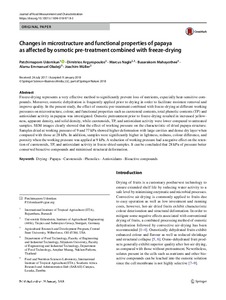| dc.contributor.author | Udomkun, Patchimaporn |
| dc.contributor.author | Argyropoulos, D. |
| dc.contributor.author | Nagle, M. |
| dc.contributor.author | Mahayothee, B. |
| dc.contributor.author | Alamu, E.O. |
| dc.contributor.author | Müller, J. |
| dc.date.accessioned | 2019-12-04T11:14:17Z |
| dc.date.available | 2019-12-04T11:14:17Z |
| dc.date.issued | 2018 |
| dc.identifier.citation | Udomkun, P., Argyropoulos, D., Nagle, M., Mahayothee, B., Alamu, E.O. & Muller, J. (2018). Changes in microstructure and functional properties of papaya as affected by osmotic pre-treatment combined with freeze-drying. Journal of Food Measurement and Characterization, 1-10. |
| dc.identifier.issn | 2193-4126 |
| dc.identifier.uri | https://hdl.handle.net/20.500.12478/2715 |
| dc.description | Published online: 20 Jan 2017 |
| dc.description.abstract | Freeze-drying represents a very effective method to significantly prevent loss of nutrients, especially heat-sensitive compounds.
Moreover, osmotic dehydration is frequently applied prior to drying in order to facilitate moisture removal and improve quality. In the present study, the effect of osmotic pre-treatment combined with freeze-drying at different working pressures on microstructure, colour, and functional properties such as carotenoid contents, total phenolic contents (TP) and antioxidant activity in papayas was investigated. Osmotic pretreatment prior to freeze-drying resulted in increased yellowness, apparent density, and solid density, while carotenoids, TP, and antioxidant activity were lower compared to untreated samples. SEM images clearly showed that the effect of working pressure on the characteristic of dried papaya structure. Samples dried at working pressure of 9 and 77 kPa showed higher deformation with large cavities and dense dry layer when compared with those at 28 kPa. In addition, samples were significantly higher in lightness, redness, colour difference, and porosity when the working pressure was applied at 9 kPa. A reduction of working pressure had a negative effect on the retention of carotenoids, TP, and antioxidant activity in freeze-dried samples. It can be concluded that 28 kPa of pressure better conserved bioactive compounds and minimised structural deformation. |
| dc.format.extent | 1-10 |
| dc.language.iso | en |
| dc.subject | Drying |
| dc.subject | Papaya |
| dc.subject | Carotenoids |
| dc.subject | Antioxidants |
| dc.subject | Osmotic |
| dc.subject | Freeze-Drying |
| dc.subject | Phenolics |
| dc.subject | Bioactive Compounds |
| dc.title | Changes in microstructure and functional properties of papaya as affected by osmotic pre-treatment combined with freeze-drying |
| dc.type | Journal Article |
| dc.description.version | Peer Review |
| cg.contributor.crp | Agriculture for Nutrition and Health |
| cg.contributor.affiliation | International Institute of Tropical Agriculture |
| cg.contributor.affiliation | Universität Hohenheim |
| cg.contributor.affiliation | Central State University |
| cg.contributor.affiliation | Silpakorn University, Thailand |
| cg.coverage.region | Europe |
| cg.coverage.country | Germany |
| cg.creator.identifier | Alamu Emmanuel Oladeji: 0000-0001-6263-1359 |
| cg.creator.identifier | Patchimaporn Udomkun: 0000-0003-0115-1997 |
| cg.researchtheme | NUTRITION & HUMAN HEALTH |
| cg.isijournal | ISI Journal |
| cg.authorship.types | CGIAR and developing country institute |
| cg.iitasubject | Biodiversity |
| cg.iitasubject | Nutrition |
| cg.journal | Journal of Food Measurement and Characterization |
| cg.howpublished | Formally Published |
| cg.accessibilitystatus | Limited Access |
| local.dspaceid | 93662 |
| cg.targetaudience | Scientists |

